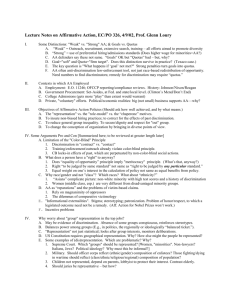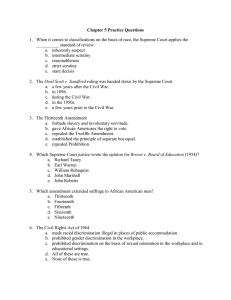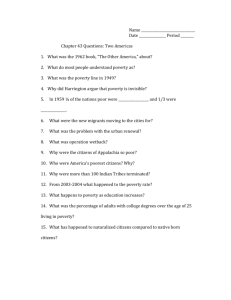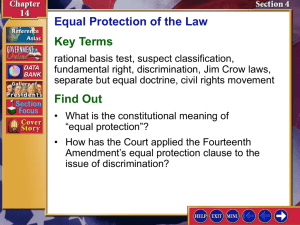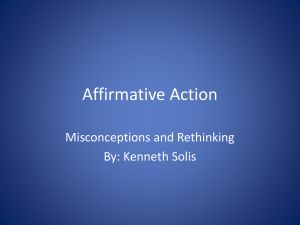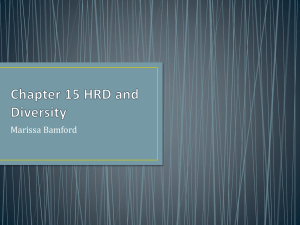File
advertisement
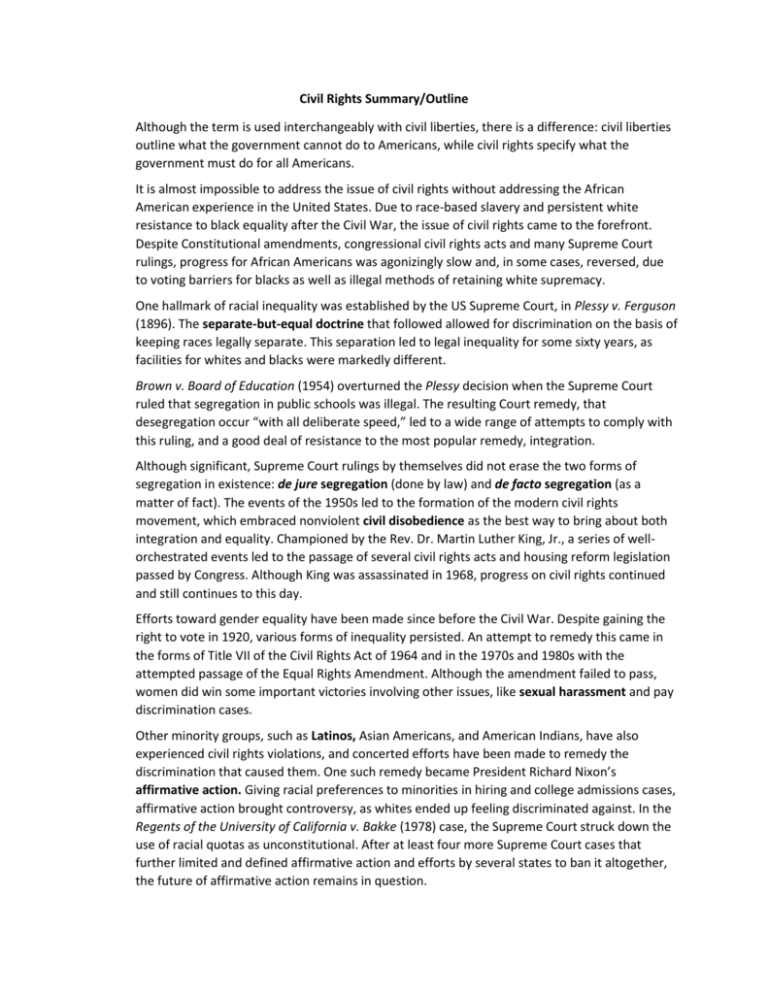
Civil Rights Summary/Outline Although the term is used interchangeably with civil liberties, there is a difference: civil liberties outline what the government cannot do to Americans, while civil rights specify what the government must do for all Americans. It is almost impossible to address the issue of civil rights without addressing the African American experience in the United States. Due to race-based slavery and persistent white resistance to black equality after the Civil War, the issue of civil rights came to the forefront. Despite Constitutional amendments, congressional civil rights acts and many Supreme Court rulings, progress for African Americans was agonizingly slow and, in some cases, reversed, due to voting barriers for blacks as well as illegal methods of retaining white supremacy. One hallmark of racial inequality was established by the US Supreme Court, in Plessy v. Ferguson (1896). The separate-but-equal doctrine that followed allowed for discrimination on the basis of keeping races legally separate. This separation led to legal inequality for some sixty years, as facilities for whites and blacks were markedly different. Brown v. Board of Education (1954) overturned the Plessy decision when the Supreme Court ruled that segregation in public schools was illegal. The resulting Court remedy, that desegregation occur “with all deliberate speed,” led to a wide range of attempts to comply with this ruling, and a good deal of resistance to the most popular remedy, integration. Although significant, Supreme Court rulings by themselves did not erase the two forms of segregation in existence: de jure segregation (done by law) and de facto segregation (as a matter of fact). The events of the 1950s led to the formation of the modern civil rights movement, which embraced nonviolent civil disobedience as the best way to bring about both integration and equality. Championed by the Rev. Dr. Martin Luther King, Jr., a series of wellorchestrated events led to the passage of several civil rights acts and housing reform legislation passed by Congress. Although King was assassinated in 1968, progress on civil rights continued and still continues to this day. Efforts toward gender equality have been made since before the Civil War. Despite gaining the right to vote in 1920, various forms of inequality persisted. An attempt to remedy this came in the forms of Title VII of the Civil Rights Act of 1964 and in the 1970s and 1980s with the attempted passage of the Equal Rights Amendment. Although the amendment failed to pass, women did win some important victories involving other issues, like sexual harassment and pay discrimination cases. Other minority groups, such as Latinos, Asian Americans, and American Indians, have also experienced civil rights violations, and concerted efforts have been made to remedy the discrimination that caused them. One such remedy became President Richard Nixon’s affirmative action. Giving racial preferences to minorities in hiring and college admissions cases, affirmative action brought controversy, as whites ended up feeling discriminated against. In the Regents of the University of California v. Bakke (1978) case, the Supreme Court struck down the use of racial quotas as unconstitutional. After at least four more Supreme Court cases that further limited and defined affirmative action and efforts by several states to ban it altogether, the future of affirmative action remains in question. Gay males and lesbians, too, had long suffered from discrimination and civil rights abuses. Beginning with the Stonewall riots of 1969, what eventually became known as the LGBTQ community started openly demonstrating in favor of gay rights, and against laws that proscribed their behavior. The resulting political controversies became a polarizing issue, as efforts to pass same-sex marriage laws led to ‘marriage amendments’ in state Constitutions and the federal Defense of Marriage Act, forbidding the federal government to recognize any marriage not between a man and a woman. Court challenges followed, along with several states legalizing gay marriage, and the issue has yet to be fully resolved—much like the state of civil rights as a whole. I. II. THE AFRICAN AMERICAN EXPERIENCE AND THE CIVIL RIGHTS MOVEMENT A. Ending Servitude 1. Constitutional Amendments. 2. The Civil Rights Acts of 1865 to 1875. B. The Ineffectiveness of the Early Civil Rights Laws 1. The Civil Rights Cases. 2. Plessy v. Ferguson: Separate but Equal. 3. Voting Barriers. 4. Extralegal Methods of Enforcing White Supremacy. C. The End of the Separate-but-Equal Doctrine 1. Brown v. Board of Education of Topeka. 2. “With all Deliberate Speed.” 3. Reactions to School Integration. D. De Jure and De Facto Segregation E. The Civil Rights Movement 1. King’s Philosophy of Nonviolence. 2. The March on Washington. F. Modern Civil Rights Legislation 1. The Civil Rights Act of 1964. 2. The Voting Rights Act of 1965. 3. The Civil Rights Act of 1968 and Other Housing Reform Legislation. 4. Consequences of Civil Rights Legislation. 5. Political Participation by African Americans. 6. Political Participation by Other Minorities. WOMEN’S STRUGGLE FOR EQUAL RIGHTS A. Early Women’s Political Movements B. The Modern Women’s Movement 1. The Equal Rights Amendment. 2. Challenging Gender Discrimination in the Courts. 3. Women in the Military. C. Women in Politics Today D. Gender-Based Discrimination in the Workplace 1. Title VII of the Civil Rights Act of 1964. 2. 3. III. IV. Sexual Harassment. Wage Discrimination. EXPERIENCES OF OTHER MINORITY GROUPS A. Immigration, Latinos, and Civil Rights 1. Hispanic versus Latino. 2. The Changing Face of America. 3. The Civil Rights of Immigrants. B. The Agony of the American Indian 1. The Demographic Collapse. 2. American Indians in the Nineteenth and Twentieth Centuries. CIVIL RIGHTS: EXTENDING EQUAL PROTECTION A. Affirmative Action B. The Bakke Case C. Additional Limits on Affirmative Action
